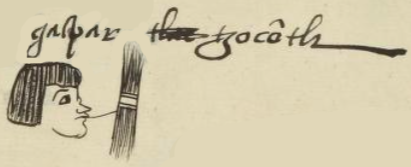Tzocotli (MH705r)
This black-line drawing of the simplex glyph for the personal name Tzocotli (perhaps “Little Bit” or “Smallest Child”) is attested here as a man’s name. The glyph shows a vertical bundle called tzontli (referring to the number 400–whether pieces of hair, tribute items such as blades of grass, sticks, etc.). The bundle is tied in the middle, as is typical for presenting such things as a tribute payment. This is a phonetic indicator that the name starts with Tzo-.
Stephanie Wood
Four hundred, of course, is a vigesimal quantity, and the Nahuas had a vigesimal (root of 20) numerical system. A gloss on another example of tzontli (a case of 10 tzontli, or 4,000) refers to the items as "ramitos" (little branches). Likewise, a century ago, 400 small pieces of firewood were bundled in what was called a tzontle, a Nahuatl loan in Spanish. (See: Paul Carpenter Standley, Trees and Shrubs of Mexico - Part 1, 1926, 806.) This may support the reading that this numeration called a tzontli could have a visual association with branches or trees. Some signs for tzontli do look like the laurel or pine branches (acxoyatl) that were part of religious rituals. Nigel Davies (Human Sacrifice, 1981, 218), in fact, called a tzontli sign a "fir tree." Zelia Nuttall (in a volume of anthropological papers called Boas Anniversary Volume, published by Berthold Laufer in 1906, 296) refers to the bundles of 400 as containing either "sticks" or "hair." Some of the tzontli glyphs across this collection, such as the example here, do look like upright bundles of sticks that are bound around the middle. A binding like the one on this glyph above also appears in the Matrícula de Huexotzinco in a glyph for Tzompan, below.
Another common visual associated with the word tzontli involves large locks of hair or even strings of hair from the head. "Hair" is often the translation for tzontli into English. This word for hair and the word for 400 would therefore serve as homonyms. Similarly, speaking of 400 tzontles, four hundred corn cobs (Calixta Guiteras Holmes, Perils of the Soul, 1961, 47), is another case where the tzontli is simply a numeration and does not reflect upon the object being counted. So, the conclusion is that a sign for 400, like all of them, whether branches, sticks, or hair, will have the role of a phonogram.
Frances Karttunen had not seen the term tzoco with anything other than endings such as -ton (diminutive) or -tzin (reverential). Here, there is a rare absolutive ending. The tlacuilo also provides an overbar, as though the name should be tzocontli, but this spelling does not seem correct, so we are ignoring the overbar. Karttunen wonders of tzoco is like xoco, referring to a smallest or youngest child.
Stephanie Wood
gaspar tzocōtli
Gaspar Tzocotli
Stephanie Wood
1560
Jeff Haskett-Wood
tributos, números, cuatrocientos, zacatl, hierbas, chiquito, joven, nombres de hombres

tzon(tli), hair or four hundred, https://nahuatl.wired-humanities.org/content/tzontli
tzoco, a little bit, https://nahuatl.wired-humanities.org/content/tzoco
posiblemente, Chico, Más Pequeño, o Más Joven
Stephanie Wood
Matrícula de Huexotzinco, folio 705r, World Digital Library, https://www.loc.gov/resource/gdcwdl.wdl_15282/?sp=488&st=image.
This manuscript is hosted by the Library of Congress and the World Digital Library; used here with the Creative Commons, “Attribution-NonCommercial-ShareAlike 3.0 License” (CC-BY-NC-SAq 3.0).





